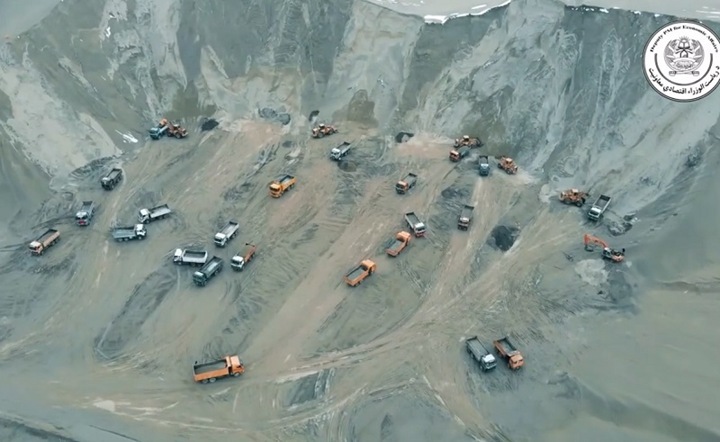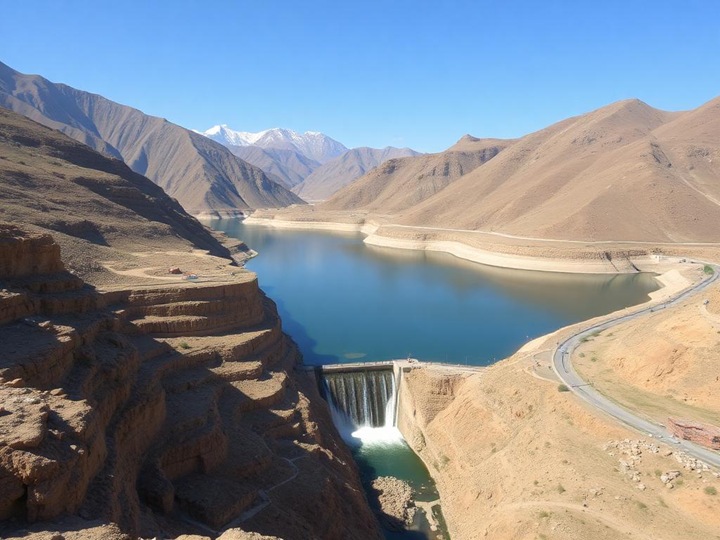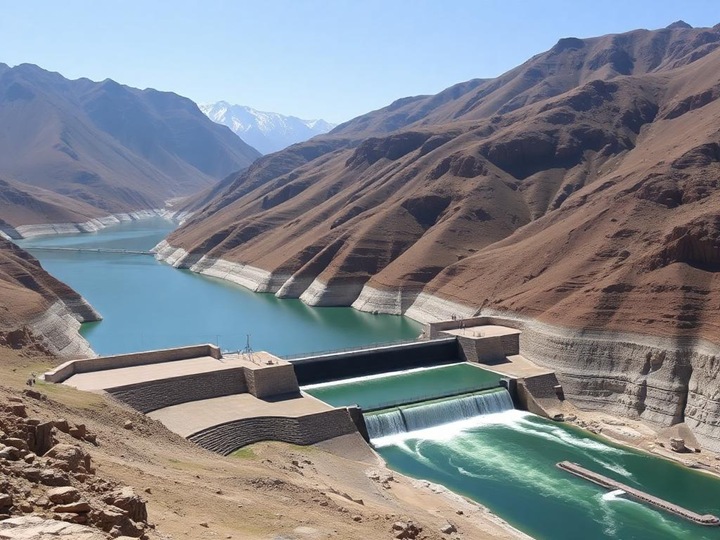Will the Qosh-Tepa Canal aggravate the water shortage in Central Asia?
A new report by the Center for the National Interest entitled “The Koshtepa Canal in Afghanistan and Water Security in Central Asia” highlights the main technical, financial and legal problems faced by the interim authorities of Afghanistan in ensuring the effective and sustainable construction of the Koshtepa Canal (sometimes spelled as Qosh-Tepa). This channel is of particular concern to downstream countries such as Uzbekistan and Turkmenistan, The Diplomat writes. Agriculture is the main consumer of water resources in both Uzbekistan and Turkmenistan, accounting for approximately 90 percent of total water consumption in each country. Agriculture contributes 17 percent to Uzbekistan’s GDP and 10 percent to Turkmenistan’s GDP, with a significant proportion of water used for cotton production.

The interim authorities of Afghanistan declare that the Qosh-Tepa canal, which is supposed to be 287 kilometers long, 8.5 meters deep and an average width of 100 meters, will irrigate more than 1.2 million acres of agricultural land and create about 200,000 jobs, which will make a significant contribution to agricultural productivity and national food security. Currently, the construction process, involving approximately 5,000 workers and 4,000 pieces of earthmoving equipment, is proceeding at an accelerated pace. The initial phase of the project has been completed and the second phase is currently in progress, with 81 percent of the excavations for the second phase already completed, according to information from the National Development Corporation of Afghanistan. The completion time of the main channel is expected to be six years, but the construction of the entire network of channels, including secondary and distribution systems, will take much longer.
Initial plans for the construction of the canal date back to the 1970s, but the Soviet invasion in 1979 marked the beginning of more than 40 years of civil unrest and violence in Afghanistan, delaying the implementation of the Koshtep project for a long time. Only in 2018, USAID commissioned a study of the feasibility of the canal, and the Ghani government began construction before its fall in August 2021. In March 2022, the Taliban relaunched the project as a flagship initiative, with a PR campaign highlighting its ambitious scope and potential impact. Visual materials with extensive construction activity emphasize the scale of the channel. As Taliban spokesman Zabihullah Mujahid stated in December 2023, the project symbolizes hope in the face of economic difficulties and represents Afghanistan’s potential for development and self-sufficiency.
The completion of the canal construction may aggravate the regional conflict, as the downstream countries dependent on agriculture, especially cotton production, may be most adversely affected by the construction of the canal. However, some experts believe that such concerns may be exaggerated. A recent study by the German Economic Team shows that even if the Koshtepa Canal diverts 25 percent of the water of the Amu Darya River, this will only lead to a 0.7 percent decrease in Uzbekistan’s GDP by 2030. One of the co-authors of the report, a researcher in the field of water resources and ecology, Najibullah Sadid, argued that the use of water in agriculture at this stage will not be significant, since the subchannels designed to transport water to the fields have not yet been created, and agricultural fields are not ready for processing.
Irrigation Projects and the Soviet Era: a cautionary Tale for Koshtep
The construction of the Karakum Canal by the Soviet Union in the middle of the 20th century remains one of the most problematic irrigation projects in Central Asia today. A canal designed to divert water from the Amu Darya River to irrigate the arid Karakum desert in Turkmenistan has led to long-term environmental and economic consequences, including a sharp reduction in the flow of the Amu Darya into the Aral Sea, which has caused one of the most famous environmental disasters in the world. However, it should be noted that the ecological catastrophe of the Aral Sea was not only the result of poor canal construction, but also wasteful water use practices of the Soviet regime and excessive dependence on cotton, a culture that requires large amounts of water as a source of export income for the USSR.
The parallels between the construction methods and accelerated pace of the Koshtepa Canal and Soviet-era projects, especially the Karakum Canal, highlight the potential risk of repeating past mistakes. The construction of the Karakum Canal used primitive folk construction sites (i.e. a large number of workers/prisoners) due to limited financial resources. The risk of structural accidents, especially the rupture of the banks of the canal, was obvious even during its creation. In order to reduce costs, the Soviet authorities adopted a simplified approach to earthworks, which was also used in other major water infrastructure projects throughout Central Asia. In addition, the waterproofing of the canal was made with outdated materials such as clay and sand, which were crushed and distributed along the bottom and walls of the canal. Like the Koshtepa Canal, the Karakum Canal was built without concrete cladding. Over time, the lack of concrete cladding led to the fact that the canal was increasingly silted up. At the beginning of 2023, according to Turkmen.news, the canal ruptured, releasing 100 million cubic meters of water into the surrounding dry sands.
The Taliban’s appeal to the Koshtepa channel strongly resembles past Soviet practices, focusing on the claimed advantages of the channel while minimizing potential risks. Politically, the channel serves as a statement for Afghanistan’s ethnic minorities, signaling the Taliban’s willingness to improve the lives of all citizens, not just the Pashtun majority. Geopolitically, the channel is positioned as proof that Afghanistan under the rule of the Taliban can successfully manage large-scale infrastructure projects and defend its national interests. These motives drive significant PR efforts around the project, as can be seen from the statements of Mullah Abdul Ghani Bardar, Deputy Prime Minister for Economic Affairs, who emphasized the emphasis of the Islamic Emirate on agricultural development and water management, citing the Koshtepa Canal as a vivid example of this commitment.
However, these political factors, as in the Soviet era, risk overshadowing important environmental and technical aspects. The accelerated nature of the project, combined with the priority of a political message over careful planning, raises the possibility of repeating expensive mistakes made during the construction of the Karakum Canal, which led to long-term environmental problems.
At the same time, the Koshtepa canal project is progressing in conditions of limited resources and pressure for rapid implementation. However, hydrologists warn that non-compliance with modern design standards can lead to significant environmental degradation. As noted in the 2023 article CABAR.asia Experts are particularly concerned that the bottom of the canal is not lined with concrete or geotextile materials, which are necessary to prevent significant water losses through seepage into sandy soil. There is also a concern that the operation of unglazed channels may aggravate soil salinization. Another critical problem is the lack of mechanisms for silt removal in the waters of the Amu Darya, which already contain a lot of sediment. These accumulating sediments are likely to reduce the operational efficiency of the canal over time.
In combination with the agro-industrial expansion of Afghanistan, this can lead to significant land degradation and increased salinity in the lower reaches of the Amu Darya River. In fact, not only will Turkmenistan and Uzbekistan receive less water from the Amu Darya, but water quality will also deteriorate.
Although there are many reasons for serious concern about the current methods of construction of the Koshtepa Canal in Afghanistan, there is still time to address these shortcomings. However, the window of opportunity for this will close in the coming years. The current concern is that there may not be enough qualified specialists in Afghanistan in the field of applied research, as well as sufficient financial resources for the construction of a valid effective channel. This situation is significantly complicated by the fact that the interim authorities are not recognized as a legitimate government, and financial transactions are severely restricted by international sanctions, including the freezing of approximately $10 billion of international reserves.
Legal issues
Given the growing water scarcity in Central Asia and the potential environmental and geopolitical consequences of the canal project, Afghanistan and its Central Asian countries should engage in dialogue and cooperate on sustainable water management practices. This is especially true as the region is facing increasing pressure from population growth, climate change and agrarian requirements that threaten further depletion of the Amu Darya’s water resources.
The history of water distribution in Central Asia is determined by outdated Soviet-era agreements, especially Protocol No. 566, signed in 1987. However, Afghanistan was excluded from this agreement, which was concluded during the Soviet military conflict in the country.
After the collapse of the Soviet Union, the newly independent Central Asian countries signed the Almaty Agreement in 1992, which continued to follow the framework established in Protocol No. 566. Afghanistan was also excluded from this agreement, and this exception means that there are currently no legal restrictions for Afghanistan to use the waters of the Amu Darya River.
The construction of the canal highlights the need for a new, more inclusive agreement on water management in the Amu Darya basin. Outdated rules on water distribution, originating from Soviet times, no longer reflect the reality of the region, where it is necessary to take into account the growing water consumption of Afghanistan. A comprehensive agreement on the Amu Darya basin, which includes Afghanistan along with other Central Asian States, is necessary to ensure long-term water security and prevent future conflicts over water resources.
All States of the Amu Darya River basin will also have to adopt more effective water use practices. The combination of a rapidly growing population and drier arid weather resulting from climate change is already putting additional pressure on depleted resources.
Urgent support of the international community and regional cooperation is required
The Koshtepa canal project, of course, did not go unnoticed by Afghanistan’s Central Asian neighbors. In 2023, Uzbek President Shavkat Mirziyoyev called for a thorough study of the construction of the canal, warning that it could “radically change the water regime” in the region. This view was confirmed by Turkmenistan, which demanded that Afghanistan adopt a “science-based approach” to water resources management, ensuring that the construction of the canal is carried out by qualified personnel to reduce environmental risks.
Despite these concerns, Uzbekistan and Turkmenistan have not yet raised formal objections, probably due to their broader geopolitical interests. Both countries are involved in important infrastructure projects with Afghanistan, including the Turkmenistan-Afghanistan-Pakistan-India (TAPI) gas pipeline, the expansion of rail links with Pakistan and cross-border energy links that require cooperation with Kabul. The fact that Turkmenistan and Uzbekistan are already pragmatically cooperating with Afghanistan in other critical infrastructure projects sets a good precedent for jointly addressing water use issues in connection with the imminent construction of the Koshtepa Canal.
At the end of October 2024, Afghanistan and Uzbekistan established a bilateral joint commission to resolve issues related to the Koshtepa Channel. The Commission has already met twice and will meet again in early 2025. At the moment, these meetings are held in a closed format, but it is important that they take place. The World Bank’s Director of Afghanistan Affairs, Faris Haddad-Zervos, also met with the Afghan Chamber of Commerce to discuss a number of issues, including the Koshtepa Channel.
These two developments are promising, but bilateral negotiations should be multilateral, and preferably the World Bank and other international financial institutions should move from preliminary negotiations to concrete projects that contribute to better canal construction, regional water use agreements and more efficient irrigation and water use methods. The published report of the Center for National Interests contains recommendations in this direction.
The time to act is coming right now. Ideally, the new Trump presidential administration should perceive the problem of water scarcity in the region as an opportunity for greater US involvement in Afghanistan and Central Asia. The growing shortage of water resources will lead to greater instability and management problems, as well as cross-border terrorist threats. Everyone saw what it led to in 2001. The Uzbek partners of the United States are well aware that the Taliban regime, although a difficult partner, is on the same side in the fight against the threat from the Islamic State of Khorasan and other groups operating on their border. Washington should listen to them regarding pragmatic interaction with Kabul, and the Koshtep Canal is the ideal place to start.
“Postasia”


